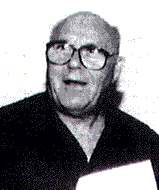
|

|
Neal M.Sher
 The Continuing Saga of Ivan Demjanjuk
The Continuing Saga of Ivan Demjanjuk
(First of two parts)
LAST MONTH, federal judge Paul Matia in Cleveland gave back to Ivan Demjanjuk his U.S. citizenship, despite the objections of Janet Reno and the Justice Department. The Judge did, however, leave the door open for the government to file additional charges and to continue to the effort to strip him of citizenship and ultimately deport him. All indications are that the Department will do just that, as the lawyers closest to the case understand full well that Ivan Demjanjuk in no way deserves the precious right of U.S citizenship. Indeed, it is hard to think of anyone less worthy. It would be a tragedy not to pursue him.
Since the case has been out of the public's eye for several years,
background is in order to understand the nature of the beast.

Matia's decision follows the 1993 ruling by the Israeli Supreme Court which overturned Demjanjuk's conviction for mass murder. Several years before, a three-judge trial court in Jerusalem determined that he was the notorious "Ivan the Terrible" who ran the gas chambers at the Treblinka death camp.
Although the Supreme Court left no doubt that Demjanjuk had served the SS and had participated in the "Final Solution", the judges decided that statements from former Treblinka guards, which had been obtained from the Soviet Union during the appeal process, suggested that the "Ivan" who manned the gas chambers was an Ivan Marchenko. Intriguingly, after the war, when asked about his mother's maiden name, Demjanjuk swore to U.S. Immigration authorities as well as the Social Security Administration that it was - you guessed it - Marchenko. In Israel, he desperately argued that he lied when he used that name, claiming he picked it out of thin air.
The Supreme Court judges not only accepted the testimony of Treblinka survivors that Demjanjuk was indeed Ivan the Terrible, they also found irrefutable evidence of his service at other death and concentration camps. Nevertheless, and despite the curious circumstances surrounding the name Marchenko, Israel's highest court gave him the benefit of the doubt and reversed the conviction. It chose to release Demjanjuk, over the objections and protests of noted legal scholars and jurists who strongly felt that the court's unequivocal findings of his role in mass murder at places other than Treblinka fully justified a life sentence.
After the Israeli Court decision, the U.S. Court of Appeals, under the heavy influence of its Chief Judge Gilbert Merritt, ordered the government to allow Demjanjuk to return to this country. Attorney General Reno objected, arguing - quite properly - that the uncontraverted evidence of Demjanjuk's involvement in Nazi persecution, as well as his repeated lies to American authorities, made him ineligible to set foot on our soil.
Merritt's court proved to be Demjanjuk's best friend, not only by bending over backwards to protect him, but also by slamming the Justice Department by finding that OSI attorneys in 1980 failed to give Demjanjuk several documents they thought he was entitled to. Merritt and company went out of their way to attack OSI, despite the fact that another federal judge - hand-picked by Merritt to look into the matter - held hearings for one and a half years and found no wrongdoing on the part of OSI attorneys. But Merritt, it seemed, was on a mission. [In Part II of this series, his scandalous behavior will be revealed in much greater detail].
Judge Matia's decision last month must be viewed within the context of this background, as he followed the lead of Merritt and his colleagues. One must hope however, that once the Attorney General authorizes a renewed prosecution focusing on the overwhelming non-Treblinka evidence, Judge Matia will have the strength and courage not to be intimidated by Merritt.
Treblinka aside, a review of the extensive public evidentiary record - amassed both here and in Israel - leaves not the slightest doubt as to Demjanjuk's role in the destruction of European Jewry.
Born in Ukraine, Ivan Demjanjuk was a soldier in the Red Army when he was captured by the Nazi forces in the spring of 1942 during the battle of Kerch in the Crimea and then held as a prisoner of war. A select and relatively small group of Soviet POW volunteers, Demjanjuk among them, was recruited for a special mission: to implement the diabolical plans of what was known as "Aktion Reinhard."
Named in "tribute" to Reinhard Heydrich, the SS chief who was assassinated by the Czech underground, the objective of this operation can be simply stated: to slaughter as many Jews as possible in as short a period of time as possible. To accomplish this, the death camps of Treblinka, Sobibor and Belzec - places now synonymous with mass murder - were built in Poland. They were nothing less than factories of death.
In preparation for their assignment, Demjanjuk and his cohorts trained at the SS camp at Trawniki, Poland. It was there that they were schooled in the business of murdering Jews. The Israeli Supreme Court described Trawniki: " it's assignment was monolithic, namely aiding the SS…to round up Jews from the cities, towns and villages and to transport them to their death, to aid in carrying out murder and to cover up, after the event, all traces of the murder. This was, therefore, a unit for aiding murder, in the plain meaning of that expression".
Demjanjuk then became part of an even more "select" band of Trawniki "graduates" when he was assigned to work in the death camps; only about 400 of the 4,000 men who trained at Trawniki served at Sobibor, Belzec and Treblinka.
The Israeli Supreme Court - to which Demjanjuk owes his freedom and life - specifically found that he was "a member of the Wachmanner, a product of the Trawniki unit, which was established for one purpose - in order to study and teach its members how to exterminate, annihilate, destroy and bring about the ‘final solution' of the ‘Jewish problem.'" The judges went on to find that Demjanjuk served at the Sobibor extermination camp and later worked as an SS guard at both the Flossenburg and Regensberg concentration camps in Germany.
These are extraordinary findings. They hardly amount to the clean bill of health which Demjanjuk's advocates and apologists claim was given him by the Israeli tribunal. On the contrary, on the basis of these conclusions, one would be hard pressed to find anyone today in any prison in this country with more blood on his hands than Ivan Demjanjuk.
It is important to understand the nature of the evidence establishing Demjanjuk's service at Sobibor. First and foremost is an SS identity card - bearing his name, date and place of birth, father's name, physical scar, identification number 1393, as well as his photo. This card must be one of the most tested, examined and analyzed piece of documentary evidence in the annals of western jurisprudence. Every judge on every court who dealt with the Trawniki card - in both The United States and Israel -found it to be fully authentic and legitimate. Demjanjuk's relentless efforts to discredit it as a KGB forgery went nowhere, as the scientific and historical corroborating evidence of its being kosher is overwhelming.
The card bears a notation that Demjanjuk was posted to Sobibor on March 27, 1943. That type of evidence, in and of itself, can, indeed has, served as a basis for stripping someone of citizenship. But the Trawniki card does not stand alone.
Another wartime document lists a number of Trawniki men who had been assigned to the Sobibor camp. Among them, Ivan Demjanjuk who was identified by name, date and place of birth and ID number 1393. The date: March 26, 1943, one day before the Sobibor entry on Demjanjuk's own Trawniki card.
As powerful as those two documents are - there is more. Confessions of another Ukrainian Trawniki Wachmann, Ignats Danilchenko, identify Demjanjuk as a fellow guard at Sobibor. He also later served with Demjanjuk at both Flossenberg and Regensburg. Danilchenko stated was "Demjanjuk was considered to be an experienced and efficient guard".
This evidence is bolstered even further by an October 1, 1943 document (found in a Russian archive) which lists both Demjanjuk and Danilchenko (with their respective identification numbers and dates and places of birth) as having been assigned to Flossenberg. Additional corroboration can be found in German national archives which house documentation establishing that both Demjanjuk and Danilchenko were posted to Flossenberg, along with yet another guard mentioned by Danilchenko in his affidavits.
One further point about Sobibor: on his application for a visa to America, he swore that he had lived in Sobibor, Poland between 1934 and 1943. At his trials he gave 2 versions as to why he gave that information, which he now claimed to be false: one story was that when he asked someone for the name of a Polish town, Sobibor was mentioned; the other was that he listed it after seeing the name on a map. The courts saw right through this nonsense - Sobibor was so small and remote that it didn't register on many maps - and the Israeli Court found that there is only one reasonable explanation for having listed Sobibor: he must have been there.
On top of this incriminating evidence are the consistent findings by American and Israeli judges that Demjanjuk's alibi testimony and his versions of his war record are not to be believed. No court has found him to be a credible witness.
It is crucial to understand the significance of being an SS Wachmann at an Aktion Reinhard death camp. First, to put things in perspective, it means that Demjanjuk he was among a mere handful of people responsible for effectuating the deaths of hundreds of thousands of innocent Jewish men, women and children. Somewhere between 3,500 to 4,000 men were trained by the Germans at Trawniki. Of them, about 120 guards served at Treblinka, 200 at Sobibor and 600 at Belzec. In approximately 18 months nearly one and a half million Jewish men, women and children were slaughtered at these sites. One and a half million in a year and a half.
The sole purpose of Sobibor was to annihilate Jews. Only Jews. To have been a Wachmann at Sobibor was to have directly participated in cold blooded, systematic mass murder. Jews arrived by train and were immediately taken to the gas chambers. Along the way they were beaten tortured, humiliated, and stripped of their dignity. All at the hands of the Wachmanner. Within 2 hours they were dead.
I remain haunted by both the enormity of the crimes and the ruthless efficiency with which they were carried out by so few: in the space of one and a half years, 200 SS auxiliary guards at Sobibor, Ivan Demjanjuk among them, effectuated the murder of over 250,000 Jews.
In the United States after the war, Demjanjuk worked in a factory
and built cars for a living. At Sobibor during the war, he killed Jews
for a living. Don't let anyone dare tell you he is a
3/1/98: Shameful Scapegoating At The Holocaust Museum